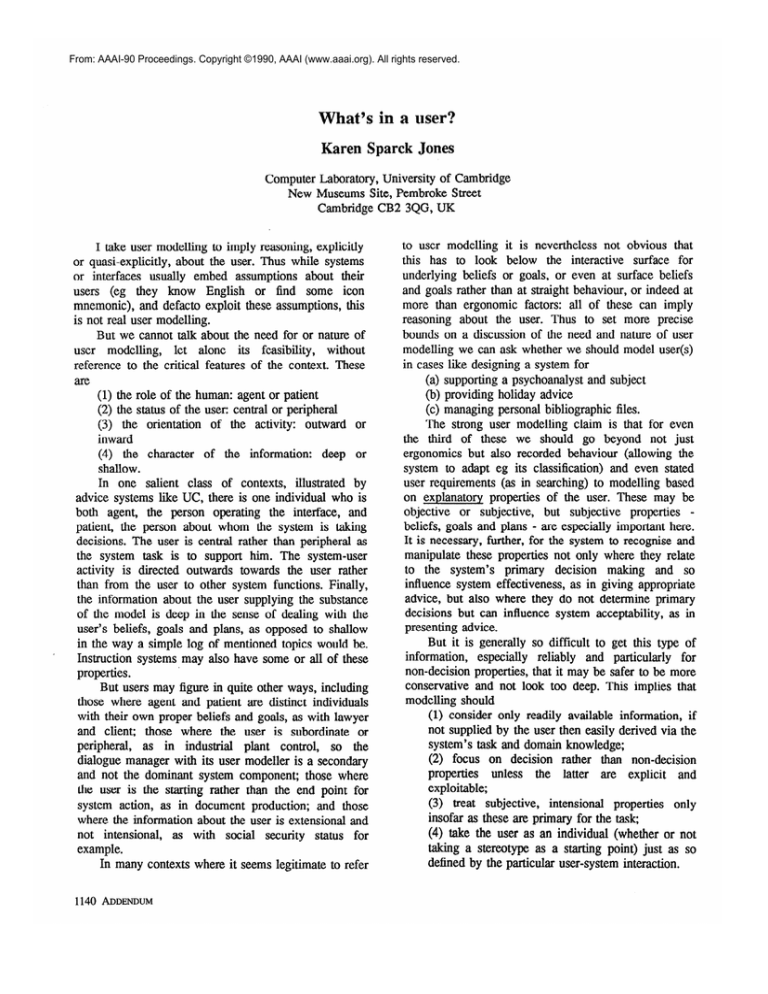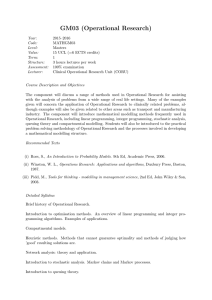
From: AAAI-90 Proceedings. Copyright ©1990, AAAI (www.aaai.org). All rights reserved.
What’s in a user?
Karen Sparck Jones
Computer Laboratory, University of Cambridge
New Museums Site, Pembroke Street
Cambridge CB2 3QG, UK
I take user modelling to imply reasoning, explicitly
or quasi-explicitly, about the user. Thus while systems
or interfaces usually embed assumptions about their
users (eg they know English or find some icon
mnemonic), and defacto exploit these assumptions, this
is not real user modelling.
But we cannot talk about the need for or nature of
user modelling, let alone its feasibility, without
reference to the critical features of the context. These
are
(1) the role of the human: agent or patient
(2) the status of the user: central or peripheral
(3) the orientation of the activity: outward or
inward
(4) the character of the information: deep or
shallow.
In one salient class of contexts, illustrated by
advice systems like UC, there is one individual who is
both agent, the person operating the interface, and
patient, the person about whom the system is taking
decisions. The user is central rather than peripheral as
the system task is to support him. The system-user
activity is directed outwards towards the user rather
than from the user to other system functions. Finally,
the information about the user supplying the substance
of the model is deep in the sense of dealing with the
user’s beliefs, goals and plans, as opposed to shallow
in the way a simple log of mentioned topics would be.
Instruction systems may also have some or all of these
properties.
But users may figure in quite other ways, including
those where agent and patient are distinct individuals
with their own proper beliefs and goals, as with lawyer
and client; those where the user is subordinate or
peripheral, as in industrial plant control, so the
dialogue manager with its user modeller is a secondary
and not the dominant system component; those where
the user is the starting rather than the end point for
system action, as in document production; and those
where the information about the user is extensional and
not intensional, as with social security status for
example.
In many contexts where it seems legitimate to refer
1140 ADDENDUM
to user modelling it is nevertheless not obvious that
this has to look below the interactive surface for
underlying beliefs or goals, or even at surface beliefs
and goals rather than at straight behaviour, or indeed at
more than ergonomic factors: all of these can imply
reasoning about the user. Thus to set more precise
bounds on a discussion of the need and nature of user
modelling we can ask whether we should model user(s)
in cases like designing a system for
(a) supporting a psychoanalyst and subject
(b) providing holiday advice
(c) managing personal bibliographic files.
The strong user modelling claim is that for even
the third of these we should go beyond not just
ergonomics but also recorded behaviour (allowing the
system to adapt eg its classification) and even stated
user requirements (as in searching) to modelling based
on explanatory properties of the user. These may be
objective or subjective, but subjective properties beliefs, goals and plans - are especially important here.
It is necessary, further, for the system to recognise and
manipulate these properties not only where they relate
to the system’s primary decision making and so
influence system effectiveness, as in giving appropriate
advice, but also where they do not determine primary
decisions but can influence system acceptability, as in
presenting advice.
But it is generally so difficult to get this type of
information, especially reliably and particularly for
non-decision properties, that it may be safer to be more
conservative and not look too deep. This implies that
modelling should
(1) consider only readily available information, if
not supplied by the user then easily derived via the
system’s task and domain knowledge;
(2) focus on decision rather than non-decision
properties unless the latter are explicit and
exploitable;
(3) treat subjective, intensional properties only
insofar as these are primary for the task,
(4) take the user as an individual (whether or not
taking a stereotype as a starting point) just as so
defined by the particular user-system interaction.
These principles apply whether natural language is the
dialogue medium or not, but clearly work out in detail
somewhat differently according to means of interaction.
In some contexts weak modelling, through
behavioural adaptation, via modifiable (though not
fixed) stereotypes, or without reference to intensional
attitudes, may be sufficient for effective and acceptable
system performance. But stronger modelling even if not
mandatory appears to be desirable, not only for obvious
cases like advice systems but in any complex system
context where user and system are both goal directed,
but the relation between their goals is not obvious and
has to be established quickly. Thus it is hard to see
how a financial advisor or literature search system
could not be improved by characterising the user’s
input in terms of knowledge and purpose, and by
establishing relationships between different inputs
through connected knowledge or purposes.
Even so, I believe that strong modelling can be
adequately done, and in the normal absence of
extensive and reliable data is best done, with only the
system’s task and domain knowledge, plus the general
conventions of communicative dialogue, to support the
given specific dialogue; and that it is neither necessary
nor sensible to go looking too hard for hidden
motivations. Too much refining on explanatory
hypotheses
is no more needed for everyday
conversation with computers than it is with people.
Thus with a holiday advisor, if the user asks about
travelling by train, just accept that he wants to travel
by train without hypothesising why (e.g. it is cheap); or
with a training system for equipment fitting, if the
apprentice asks which bit is the pobjoy just say which,
without considering all the bits the apprentice might
think is the pobjoy and telling him they are not.
Conservative strategies like this allow for some
evaluation of goals and preferences in task and domain
terms, as in UC; but they stop speculation getting out
of hand.
JONES 1141




